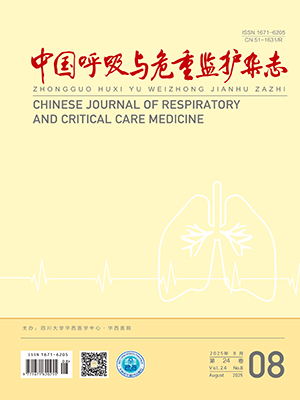| 1. |
Jimenez PN, Koch G, Thompson JA, et al. The multiple signaling systems regulating virulence in Pseudomonas aeruginosa. Microbiol Mol Biol Rev, 2012, 76(1): 46-65.
|
| 2. |
Heeb S, Fletcher MP, Chhabra SR, et al. Quinolones: from antibiotics to autoinducers. FEMS Microbiol Rev, 2011, 35(2): 247-274.
|
| 3. |
Passador L, Cook JM, Gambello MJ, et al. Expression of Pseudomonas aeruginosa virulence genes requires cell-to-cell communication. Science, 1993, 260(5111): 1127-1130.
|
| 4. |
Holm, A., and Vikström, E. Quorum sensing communication between bacteria and human cells:signals, targets, and functions. Front Plant Sci, 2014, 5: 309.
|
| 5. |
刘晓岚, 宋志军, 陈一强, 等.群体感应系统缺陷对大鼠铜绿假单胞菌慢性肺部感染的影响. 中华医院感染学杂志, 2008, 18 (4): 463-466.0.
|
| 6. |
Smith RS, Fedyk ER, Springer TA, et al. IL-8 production in human lung fibroblasts and epithelial cells activated by the Pseudomonas autoinducer N-3-Oxododecanoyl homoserine lactone is transcriptionally regulated by NF-kB and activator protein-2. J Immunol, 2001, 167(1): 366-374.
|
| 7. |
Winstanley C, Fothergill JL. The role of quorum sensing in chronic cystic fbrosis Pseudomonas aeruginosa infections. FEMS Microbiol Lett, 2009, 290(1): 1-9.
|
| 8. |
Saraswathi P, Beuerman R. Interaction of polymorphonuclear neutrophils (PMNs) with Pseudomonas aeruginosa in biofilms in corneal infections in the mouse. Invest Ophthalmol Vis Sci, 2015, 56(7): 4047.
|
| 9. |
杨旺, 陈松, 杨振德, 等. 铜绿假单胞菌 Las 系统信号分子对小鼠巨噬细胞影响的体外研究. 生物化学与生物物理进展, 2013, 40(11): 1107-1115.0.
|
| 10. |
Kravchenko VV, Kaufmann GF, Mathison JC, et al. Modulation of gene expression via disruption of NF-kappaB signaling by a bacterial small molecule. Science, 2008, 321(5886): 259-263.
|
| 11. |
Tateda K, Ishii Y, Horikawa M, et al. The Pseudomonas aeruginosa autoinducer N-3-oxododecanoyl homoserine lactone accelerates apoptosis in macrophages and neutrophils. Infect Immun, 2003, 71(10): 5785-5793.
|
| 12. |
Schwarzer C, Fu Z, Patanwala M, et al. Pseudomonas aeruginosa biofilm-associated homoserine lactone C12 rapidly activates apoptosis in airway epithelia. Cell Microbiol, 2012, 14(5): 698-709.0.
|
| 13. |
Holban A, Bleotu C, Chifiriuc MC, et al. Role of Pseudomonas aeruginosa quorum sensing (QS) molecules on the viability and cytokine profile of human mesenchymal stem cell. Virulence, 2014, 5(2): 303-310.
|
| 14. |
Vikström E, Bui L, Konradsson P, et al. Role of calcium signalling and phosphorylations in disruption of the epithelial junctions by Pseudomonas aeruginosa quorum sensing molecule. Eur J Cell Biol, 2010, 89(8): 584-597.
|
| 15. |
Ritchie AJ, Jansson A, Stallberg J, et al. The Pseudomonas aeruginosa quorum-sensing molecule N-3-(oxododecanoyl)-L- homoserine lactone inhibits T-cell differentiation and cytokine production by a mechanism involving an early step in T-cell activation. Infect Immun, 2005, 73(3): 1648-1655.
|
| 16. |
Glucksam-Galnoy Y, Sananes R, Silberstein N, et al. The bacterial quorum-sensing signal molecule N3-oxo-dodecanoyl-L-homoserine lactone reciprocally modulates pro- and anti- inflammatory cytokines in activated macrophages. J Immunol, 2013, 191(1): 337-344.
|
| 17. |
Grabiner MA, Fu Z, Wu T, et al. Peudomonoas aeruginosa quorum-sensing molecule homoserine lactone modulates inflammatory signaling through PERK and eI-F2α. J Immunol, 2014, 193(3): 1459-1467.
|
| 18. |
Cooley MA, Whittall C, Rolph MS. Pseudomonas signal molecule 3-oxo-C12-homoserine lactone interferes with binding of rosiglitazone to human PPARγ. Microbes Infect, 2010, 12(3): 231-237.
|
| 19. |
Maurer S, Wabnitz GH, Kahle NA, et al. Tasting Pseudomonas aeruginosa biofilms: human neutrophils express the bitter receptor T2R38 as sensor for the quorum sensing molecule N-(3-oxododecanoyl)-l- Homoserine Lactone. Front Immunol, 2015, 6: 369.
|
| 20. |
Valentine CD, Anderson MO, Papa FR, et al. X-box binding protein 1 (XBP1s) is a critical determinant of Pseudomonas aeruginosa homoserine lactone-mediated apoptosis. PLoS Pathog, 2013, 9(8): e1003576.
|
| 21. |
Schwarzer C, Fu Z, Morita T, et al. Paraoxonase 2 serves a proapopotic function in mouse and human cells in response to the Pseudomonas aeruginosa quorum-sensing molecule N-(3-oxododecanoyl)- homoserine lactone. J Biol Chem, 2015, 290(11): 7247-7258.
|
| 22. |
Karlsson T, Turkina MV, Yakymenko O, et al. The Pseudomonas aeruginosa N-acylhomoserine lactone quorum sensing molecules target IQGAP1 and modulate epithelial cell migration. PLoS Pathogens, 2012, 8(10): e1002953.
|
| 23. |
Kalia V C, Purohit H J. Quenching the quorum sensing system: Potential antibacterial drug targets. Crit Rev Microbiol, 2011, 37(2): 121-140.
|
| 24. |
Hancock RE, Nijnik A, Philpott DJ. Modulating immunity as a therapy for bacterial infections. Nat Rev Microbiol, 2012, 10(4): 243-254.
|
| 25. |
Chang CY, Krishnan T, Wang H, et al. Non-antibiotic quorum sensing inhibitors acting against N-acyl homoserine lactone synthase as druggable target. Sci Rep, 2014, 4: 7245.
|
| 26. |
Valentine CD, Zhang H, Phuan PW, et al. Small molecule screen yields inhibitors of Pseudomonas homoserine lactone-induced host responses. Cell Microbiol, 2014, 16(1): 1-14.
|
| 27. |
Miyairi S, Tateda K, Fuse ET, et al. Immunization with 3-oxododecanoyl-L-homoserine lactone-protein conjugate protects mice from lethal Pseudomonas aeruginosa lung infection. J Med Microbiol, 2006, 55(Pt 10): 1381-1387.
|
| 28. |
Golpasha ID, Mousavi SF, Owlia P, et al. Immunization with 3-oxododecanoyl-L-homoserine lactone-r-PcrV conjugate enhances survival of mice against lethal burn infections caused by Pseudomonas aeruginosa. Bosn J Basic Med Sci, 2015, 15(2): 15-24.
|




